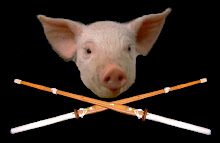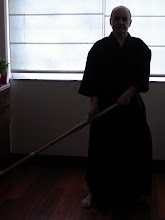I think there are many types of seme that you know. In particular what I pay attention to during keiko is “ki no seme” (spiritual pressure), “kensen no seme” (pressure of the shinai tip), and “ashi no seme” (pressure via footwork). “ki no seme” is expressed through the confidence you have when facing your opponent,
Point: Pay attention to three types of seme: spiritual, shinai tip, and footwork.
And one manner to express this is through your kamae, which we discussed before. You must develop your own kamae, one that you have self-confidence in.
This confidence – that you can execute and deliver correct techniques from your kamae – will be able to be felt by your opponent. This is the first important point. Accordingly, spiritual pressure will naturally occur. In other words, it’s important to have confidence in your kamae.
Point: Ki no seme comes out of acquiring a correct kamae and having confidence that you can strike from it.
Another important point is, of course, that you should think of the shinai as a sword. To express power through your kensen is vital. To express this you should lower your kensen as much as you can in order to pressure your opponent.
Point: Kensen no seme is achieved through lowering your shinai tip and pressuring your opponent through the power expressed in the tip.
As an action you could just move the kensen down or you could, for example, push down on the opponent’s shinai from above, etc., the point being that you should keep in mind the need to express power through your kensen at all times during keiko. This is the second point.
The third point is that you should pressure your opponent from your lower body, not just your upper body. This is seme from your leg/foot, your knee, from the tips of your toes, that is, seme from your right leg. I believe this is very important. However, it’s important that when you seme in this manner that it leads to a strike of some sort.
Point: Kensen no seme is achieved through lowering your shinai tip and pressuring your opponent through the power expressed in the tip.
You shouldn’t just move your right foot out and stop, as not only may your posture be compromised but it may lead to your opponent pressuring you instead. You must always keep this in mind.
So it seems that we have come back to the start: the importance of acquiring and having confidence in your own kamae is key in being able to seme. Please keep this in mind.
Toru KAMEI Sensei’s Kendo Lecture
The text of this note is an excerpt of DVD> Toru Kamei's Kendo Improvement Course () Book – 2017/6/1 Toru Kamei (Author) and Toru Kamei's Kendo Improvement Course () Book – 2017/6/1
Registration information
Release date: 2017/6/1
ISBN-10: 4884584074
ISBN-13: 978-4884584078
Publisher: Physical Education and Sports Publisher (2017/6/1)










